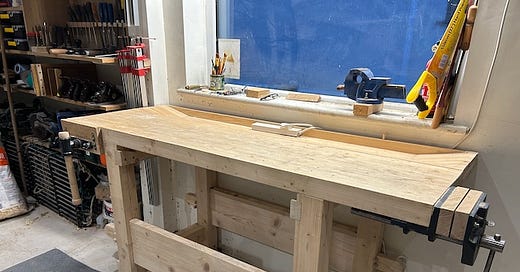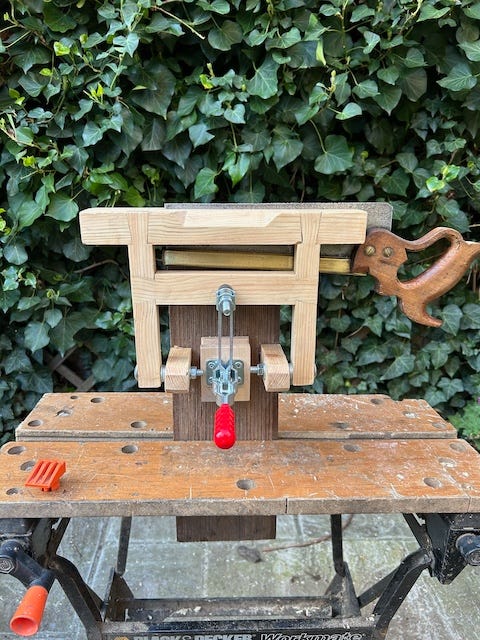In the beginning…
For 25 years as a woodwork hacker I’d pottered along quite happily with a Black and Decker Workmate as my only workbench.
Then in 2022 I re-discovered the joy of woodworking and realised I’d need something more solid to support my projects.
I spend my time between two locations. In the country I have a double garage with plenty of space for a workbench. In the town I have a small garden and a very small shed. I’m working with wood in both places.
I acquired my Workmate from a friend called Lisa. It may have belonged to her father so it was old even when I borrowed it. I don’t think she wanted it back.
That Workmate has served me well. I married Jenny. Jenny had trained as an architect. We bought a house and had children. I know people who’ve hired an architect to work on their house, and then fallen out with their architect. We’ve avoided that. Jenny is no longer an architect but she is still my wife and for many projects, my client.
The Workmate has been good enough for hacker woodwork and simple projects as it followed us around various house moves and renovations. It has some advantages. It folds away which is handy for the shed. I can walk all around it. It has a Moxon-like vice. It may have plastic handles, and the vice is only the thickness of the wooden top (18mm) but it grips like a dog with a bone. And I can set it up and work in the garden. But if I am to progress beyond hacker on this journey towards being a craftsmen I needed a better bench.
I had Workmate in London but nothing to work on in my garage in the country. In the country I had space and a roof and I wouldn’t need to stop work when it was raining. Or dark. But above all I now had the time, inclination and place to build a proper workbench.
First build your workbench..
I started to research what workbench I could build easily and cheaply. I had time off over Christmas and New Year in 2022 when I could start the work.
There are a lot of people on YouTube showing how to build a workbench. Once I’d rejected all those who assumed I already had access to major power tools: a table saw, a jointer, a thicknesser and a mitre saw the choices reduced a lot. The only two people who seemed to be offering help for people like me back in 2022, with my hand tools and basic skills, were Rex Kreuger and Paul Sellers.
Since then I’ve discovered Alex Jordon on Grey Otter and Mark at Start Making Woodworking - both of whom are doing a great job in documenting their own journey to woodworking excellence. Alex has since released his workbench video. Mark hasn’t made a workbench yet, but he’s dedicated 5 video episodes to building his workshop and I suspect a workbench video can’t be far away.
Chris Schwarz is perhaps most widely known for his book The Anarchist Toolchest. He has also written three books on building woodworking workbenches. You’ve probably already found him here here on Substack. Matt Estlea and Rex Kreuger have useful videos on the books that have inspired them and Chris’s book Workbenches is in their top choices. It’s a useful guide. Now I know more about different types of workbench vices than I ever thought I’d need to know. Chris is inspiring but his workbench projects are too hard for a mere hacker to take on. (I think he wants it that way).
Paul Sellers likes the traditional English, or Nicholson workbench. His worktop is 6 pieces of 2 x 4 CLS construction timber (CLS being Canadian Lumber Standard I discovered) salvaged from someone else’s discards. Some would say a pine worktop is too soft, but it’s cheap (or free) and easy to make.
Rex Kreuger is a fan of building workbenches. I’ve found designs for 7 different variations of workbenches on his YouTube channel and at least 14 videos on building a workbench or fitting things to them. I suspect there are more. Rex doesn’t quite start on the floor but he gets close. His Roman saw bench has short legs and sits barely a foot from the ground. Simple to make with only a few tools, it’s functional. Rex recommends it as a starter bench or for cutting large pieces of wood by hand.
I was confident I could build a full-height bench and wanted something where I could push myself to learn new skills whilst building it. Rex’s “knock down” workbench won me over (plans available here). It’s a unique design, inspired by three of the traditional styles covered in Chris Schwarz book - the English, Moravian and Roubo. A purist may mock Rex’s design but it had all that I needed. Like Paul, Rex builds his bench from construction timber. As the name implies, the bench can be dismantled and stored when not in use. The charm for me is that this bench goes together with no bolts, only wedges and wooden pins in a traditional style, but it is rock solid to use when put together.
This was the first real furniture I’d be making. Rex’s design uses large simple dovetails, mortice, tenons and lap joints. They are straightforward to make and forgiving for beginners. And, as I was to find, very satisfying when they work out well.
I aso liked the idea of a bench that I could dismantle. Maybe I could move it outside when the weather is good.
I started building the Rex-inspired bench in December 2022 and finished it in July 2023. I don’t get to visit that garage very often so projects progress slowly. The finished bench surpassed my expectations and I surprised myself with what I could achieve. Nine months later and the bench has provided me with all that I need to take on some more ambitious projects and make some proper furniture. And unlike my Workmate it doesn’t wobble.
Onto my second workbench
Now in 2024 I’m taking my work up a level. I’m on the journey to creating 30 dovetails. I want to make real furniture in London as well as in my garage in the country. I need to upgrade from the Workmate and build another workbench.
The design for my next workbench is evolving in my mind. It will be a traditional bench, but with wheels that fold away so I can move it in and out of the small shed but still be stable and solid enough to cope with some heavy mallet action on my chisels. I like Rob Cosman’s design with an MDF top. He recommends Baltic Birch plywood for the legs and frame but that’s too pricey for my liking. Instead, I’ll be using driftwood I’ve collected from the beach and offcuts from a neighbour’s building project. It’s surprising the quality of timber that gets washed up around here and the idea of a workbench from recycled wood is very appealing. Other than the cost of the MDF the timber for this bench should be completely free. That will be finished this summer.
In the meantime, that original Workmate is proving good enough in London to help me improve my dovetails skills, restore the saws and planes I’ve been buying on Ebay and support another Rex Krueger project, the saw vice. More on that later. But a proper solid workbench will make a big difference. Now I just need to get that built then hope for a break in the rain so I can actually use.






I went with Paul Sellers' bench, built between a couple of summers home from school. Took me a long time to be okay with imperfection, but I'm sitting next to it in my campus housing right now and it exudes joy. I do too, for that matter, when I look at all the stuff on it and think about the over-long list of projects I've got planned.
You're encouraging me to start dovetailing for practice, I've been too nervous and perfectionistic to try yet. I think I will. Thank you, Matthew. Keep woodhackering and sharing your story.
Nice workbench. I started with Christopher Schwarz workbench books, and built my mostly Roubo style workbench (single top, no split) without a jointer nor a planer, just a bandsaw, hand planes, handsaws, winding sticks and a cordless drill with a good guide. It can be disassembled into a top, two leg assemblies and two rails. But it has removable casters so I can easily move the 330 lb beast around the shop if needed. I love my Benchcrafted vises.